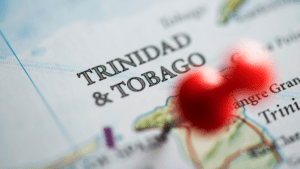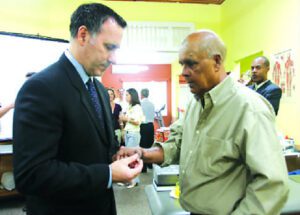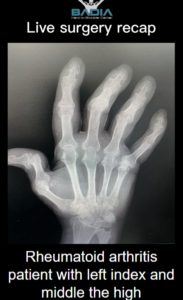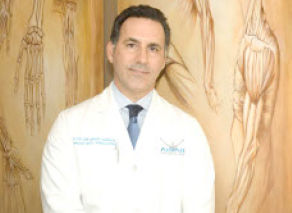
Hand Surgeon’s Humanitarian Mission: Trinidad & Tobago
Renowned hand surgeon, Dr. Badia, introduced a revolutionary treatment regimen using an innovative machine to diagnose and treat muscle problems. The treatment, known as ARPwave, brought relief to patients, including a former rugby player recovering from a car accident and two children with cerebral palsy, enabling them to regain hand function. Dr. Badia emphasized the importance of seeking specialized care for hand and upper limb issues, highlighting the need for increased collaboration and funding to advance medical treatments in Trinidad & Tobago. Respected American hand surgeon Dr Alejandro Badia visited the Caribbean recently to give Trinidad & Tobago Patients with particularly serious conditions the benefit of an expertise that does not exist here.. He gave some patients a new treatment regimen that uses a special machine to detect and treat muscle problems. One patient was a former rugby player who’d lost the use of his lower body in a car accident and was recently having the use of his upper body restricted by severe pain. After administering the treatment—called ARPwave—the pain diminished within 15 minutes and he was able to raise his arm, said Badia. Two children with cerebral palsy who couldn’t open their hands—a common problem among those with the condition—were able to do so after being treated with ARP Wave (Neuro Muscular Therapy). Badia: People not seeing right kind of doctor Dr Badia said there are many people in T&T who suffer from hand and upper limb problems that they think they have to live with because they haven’t been seen by the right kind of doctor. “If you haven’t seen a specialist, there’s a decent chance he can help you,” said Badia, “but the problem is the public has no idea that that specialty exists. Dr Badia, who was born in Cuba but grew up in New Jersey, now runs a clinic in Miami, where he says he sees a lot of Caribbean and Latin American patients. He’s forged links with doctors from countries in these regions—including T&T—and assists with difficult cases via phone and the Internet. Occasionally he visits, seeing patients and demonstrating his skills to medical professionals. This last visit to T&T was his fourth. His believes his origins and regular exposure to patients from the region make him better suited to treat them than most hand specialists in the US. “I can lime with the best of them,” he said with a laugh. NGO established for upper limb problems As there are no hand specialists in T&T, treatment of upper limb problems are done by orthopedic specialists like Godfrey Araujo, who collaborated with Badia and others to establish the Caribbean Hand Centre five years ago. Araujo and a small team of medical practitioners and physical therapists run the centre, an NGO that provides treatment of and training in the hand and upper limb area, with the invaluable assistance of specialists abroad. “Up to this morning I (was) on e-mail with him, asking advice on cases,” said Araujo, talking about Badia during a recent phone interview. While Araujo is an orthopaedist, he has devoted himself to improving his knowledge of hand and upper limb treatment. He shares a practice, Fracture and Orthopaedic Clinic Ltd, with other orthopaedists and this has allowed him to focus on that area, while his colleagues treat the other extremities. He’s gained a solid reputation in T&T. “He very nobly took on the task of developing his hand surgery skills,” Badia said of Araujo. “If he gets a complex case he consults with me, but he’s been doing a great job.” Adrian Foncette’s story is an example of the difference a subspecialist like a hand surgeon can make. The football player had severely injured his elbow in a car accident. Doctors told him he would not be able to play football again. Badia took on the case and performed a tendon transfer operation on the young man. Foncette, who went on to play college soccer in the US, is now a goalkeeper in the T&T Pro League. The medical collaboration has achieved other things. In 2012, the centre established a children’s hand and upper limb clinic at the Princess Elizabeth Home, in Port-of-Spain, with equipment donated by US hand surgeons Terry Whipple and Ty Cobb. The intricate surgical joint procedure arthroscopy is now being performed in T&T, including the public hospitals in San Fernando, Sangre Grande and Mt Hope. And Dr Araujo is using ultrasound to diagnose and treat problems. More local–foreign collaboration needed The treatment of hand and upper limb conditions in T&T still has a long way to go, and Araujo believes the key is local–foreign collaborations. “There needs to be a program collaboration so that we get our (medical) students into developed countries, where they can have fellowships,” he said. The centre would like to organise more regular visits from “super specialists” and expose patients to cutting edge technology, but funding, of course, is a big obstacle. The centre relies on donations and fundraisers, like an annual movie premiere that is coming up soon. As an example of the high cost of top-notch medical treatment, Araujo pointed to the work of Dr Bruce Rubin, a neurologist, also based in Miami, who visited along with Badia. Rubin had some good results in treating cerebral palsy patients with Botox, which costs US$400 a vial. A doctor can use up to four vials per limb, said Araujo. “It’s a lot of money,” he said. “And the people who need the treatment in Trinidad (are not from) a wealthy sector.” Related Badia middle finger MCP cricket player Michael Agard after surgey Badia middle finger MCP cricket player Michael Agard after surgey… Read More Consultorio: Síndrome del túnel carpiano Consultorio: Síndrome del túnel carpiano Febrero 14, 2014 Debe su… Read More Telemedicina: internet aplicado a la salud Telemedicina: internet aplicado a la salud Agosto 11, 2017 La… Read More Load More





